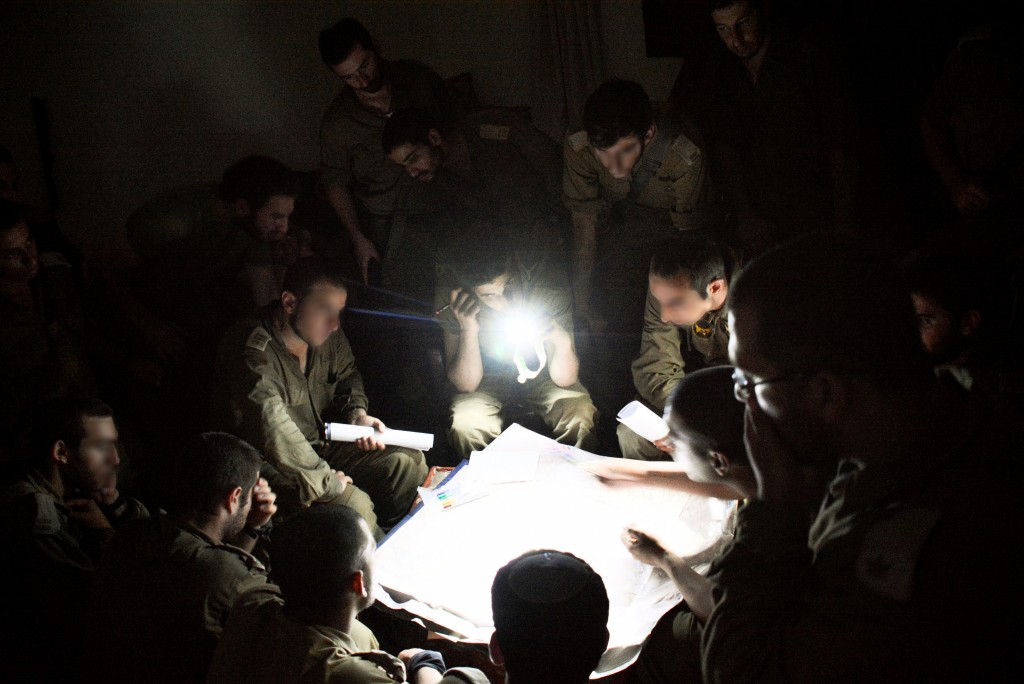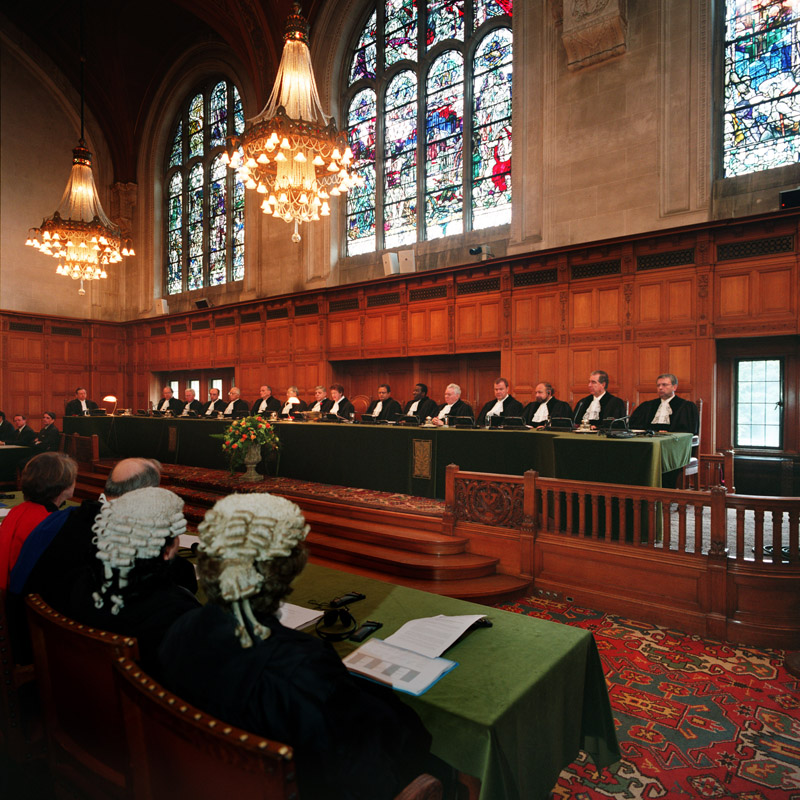At last: Your comprehensive guide to the laws of armed conflict as they apply to Operation Protective Edge.
War crimes. Disproportionate response. Collective punishment. Targeting civilians. Throughout Operation Protective Edge, these terms have been fired off at Israel with the same intensity and frequency as Hamas’ rockets. Arab government spokesmen constantly refer to Israel’s actions as “aggression.” In extreme cases, Israel is accused of “genocide” and “ethnic cleansing.”
When politicians, pundits, or the public misuse these terms, one can only think of a quote from The Princess Bride: “You keep using that word. I do not think it means what you think it means.” But when a respected jurist like Navi Pillay, the U.N. High Commissioner for Human Rights, calls Israel’s military campaign “disproportionate,” claims the IDF’s “disregard for international humanitarian law and for the right to life was shockingly evident” in many of its attacks, and says that Israel is insufficiently protecting Gaza’s civilians “in a manner that could amount to war crimes,” the accusations cannot be so easily dismissed. At the same time that Israel is exercising its right to self-defense against terrorists who violate and shamelessly exploit international law, human rights lawyers and UN officials aim to manipulate the laws of war to reduce its ability to lawfully use military force.
This article is not a rejection or disparagement of the laws of war themselves, but an attempt to accurately define the laws’ requirements. It is also a critique of the abuse of international law by politically motivated jurists whose actions only serve to undermine the legitimacy of the law, leading many respected scholars to question the law’s “inadequacy” in dealing with modern combat. These laws are still valid and fully adequate when properly understood and objectively applied, and this critique is made in the interest of preserving them and the objectivity on which they must be based.
The laws of armed conflict are essentially broken down into two main parts: Jus ad bellum, which governs the right of a state to use armed force in self-defense, and jus in bello, which determines the legality of actions taken in a war. Assessing the legality of Israel’s military actions in Gaza must begin with jus ad bellum, tackling the issue of whether Israel was justified to go to war against Hamas at all.
One of the common accusations directed at Israel is that its war with Hamas in Gaza constitutes aggression. Turkish president Recep Tayyip Erdogan labeled Protective Edge as aggression. Tunisian president Moncef Marzouki called on the Arab League to convene and discuss methods of ending “the Israeli aggression in Gaza.” Iranian Foreign Minister for Arab Affairs Hossein Amir Abdolahian topped them both, denouncing the “Zionist entity” for “barbaric aggression.” The list of Middle Eastern politicians and public figures accusing Israel of committing a war of aggression could go on for much longer. In fact, it seems to be a knee-jerk reaction to make such an accusation whenever Israel undertakes any military action. But is it true?
There is no clear or universally accepted definition of a “war of aggression,” but the relevant documents (General Assembly Resolution 3314 and the 2010 Amendments to the ICC Statute, Article 8 bis) and scholarly works indicate that aggression is the “use of armed force by a State against…another State…in any manner inconsistent with the Charter of the United Nations.” In other words, it is the unprovoked initiation of unlawful offensive force unmotivated by considerations of, or justified by, any form of necessary and lawful self-defense.
The lawfulness of these actions must be approached contextually. Professor Lung-Chu Chen of New York Law School says that a “developing process of coercion” may reach a point where a victim state must immediately and proportionately respond militarily to protect itself or its citizens. He continues, “Law cannot reasonably ask and expect a target state to wait like a sitting duck to see its own destruction in the face of such danger.” So a war is aggressive, and therefore illegitimate, if the use of force is unjustified by necessity. But what is necessity?
Necessity is a constant assessment—at the onset of hostilities and throughout—of whether defensive armed force is necessary to halt and repel an armed attack, or whether peaceful alternatives exist. The existence of necessity is determined from the context of the events, and exists where an attacker, wanting to harm a country’s sovereignty or sense of security, carries out substantial attacks against the target state. Some scholars argue that only in the case of an “isolated armed attack” must a state reasonably verify the futility of diplomacy and peaceful alternatives before resorting to force; others say that exercising self-defense need not be the final resort at all. As Oscar Schachter, a former president of the American Society of International Law, emphasized, “[a] State is not obliged to turn the other cheek” in the case of an ongoing armed attack. Nor is it obligated to compromise its sovereignty. Only manifested unwillingness to address diplomatic channels, which need only be utilized in good faith, would indicate unlawfulness.
Israel was provoked into launching Protective Edge by continued rocket and mortar fire from Gaza into southern Israel, for which Hamas, as the ruling government in Gaza, is ultimately responsible. Protective Edge grew out of the prior Operation Brother’s Keeper, launched in the West Bank after Hamas operatives from Hebron kidnapped three Israeli teenagers. Hamas denied responsibility (though eventually admitted it), and refused to return the teens. Instead, between July 2 and 7, it launched 230 rockets into Israel. The cycle of escalation led to the launching of Protective Edge on July 8. Additionally, for some time Israel possessed intelligence that Hamas had built a large offensive tunnel network leading into Israel, discovering three of them in 2013.
Israel repeatedly resorted to diplomacy, only to be repudiated by Hamas.
Israel repeatedly resorted to diplomatic means to achieve the (reasonable) goal of Protective Edge: Ending the increasing threat that Hamas poses to Israel’s security and the lives of its citizens. Israel agreed and adhered to multiple humanitarian ceasefires of varying duration, but Hamas repeatedly violated them, entering them in bad faith and only as a ruse. Hamas said it would not agree to a permanent ceasefire unless its demands were fully met—namely, lifting Israel’s (legal) blockade and opening all crossings to the passage of humans and materiel. Reports indicate that Israel agreed to many of these demands, but Hamas also demanded the re-opening of Gaza’s airport and seaport—expected to serve as an entry point for Iranian weapons—a demand it knows Israel can never accept. Hamas’ bad-faith negotiations and constant refusal to disarm leaves Israel with no option but to fight, making Israeli military action necessary.
So Israel had to go to war. Hamas left Israel with no other choice if Israel wanted to protect the lives and property of its civilians. But even if Israel’s war was necessary, it could still incur guilt for initiating a war of aggression if it responded with comprehensive force to minor Hamas provocations.
When political leaders—including the UN’s deputy secretary-general and the UK’s deputy prime minister—speak of Israel’s “disproportionate” response to Hamas, they are inaccurately invoking jus ad bellum proportionality, which determines the permissible intensity and magnitude of a defensive military action, stipulating that the force used against another side must be proportional to the threat posed to the victim state. As Professor Enzo Cannizzaro wrote in the International Review of the Red Cross, “A proportionate response…is [one] necessary and appropriate to repel the attack…using the means appropriate to the particular circumstances.”
Rosalyn Higgins, the former president of the International Court of Justice, said that proportionality must be judged in relation to the overall legitimate objective of ending a prior aggression, and permits “a use of force…more severe…than any single prior incident might have warranted.” As Roberto Ago, another former ICJ judge, wrote,
It would be mistaken, however, to think that there must be proportionality between the conduct constituting the [initial] armed attack and the opposing conduct. The action needed to halt and repulse the attack may well have to assume dimensions disproportionate to the attack suffered. What matters…is the result to be achieved [by the defensive action]…not the forms, substance and strength of the [defensive] action itself.
Keiichiro Okimoto, who now works at the UN’s Office of Legal Affairs, confirms that proportionality “does not require the same means and methods to be used in response to an armed attack.” While the a state cannot launch total war in response to minor incidents, writes Professor Tom Ruys of the University of Ghent, “an overly rigid interpretation…is universally rejected…there is no need for the defensive action to be restricted to exactly the same weapons or the same number of armed forces as the armed attack.”
All of that legalese essentially means that when a country goes to war, it is allowed to use as much force as is necessary to stop the threat that caused it to go to war to begin with, and does not have to limit itself to the same means or level of intensity used by the enemy. While necessity determines the situations allowing a state to use some form of armed force, proportionality determines the breadth of that permissible force. The intensity of a state’s response is governed by the magnitude of the threat posed to it by the enemy that attacked it, and not of the individual attacks it suffered.
So, the measuring stick of proportionality can’t be the tit-for-tat analysis of death tolls popularly presented in the media. Israel is not obligated to employ only the lightest means at its disposal against Hamas, whose military might pales in comparison. Israel is also not obligated to ensure that the death count on both sides is close to equal. That would be absurd.
This popular interpretation of proportionality would essentially forbid a nation from winning a war, allowing the aggressor to set the parameters of the subsequent hostilities. This would then obligate Israel to resort to the most comparatively primitive methods of warfare, since those are the means with which Hamas initiated hostilities, and to end its war with Hamas in a tie. As a result, the threat posed by Hamas would be no less than what it was at the outset of Protective Edge. What would then be the point of going to war at all?
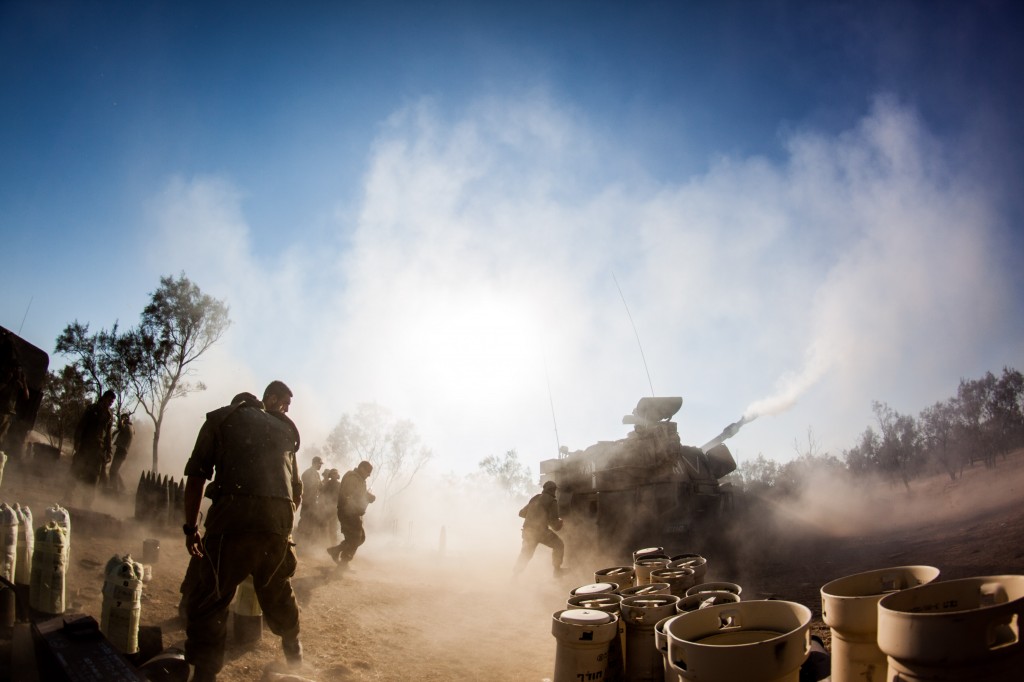
IDF artillery forces fire into the Gaza Strip on July 16 as part of Operation Protective Edge. Photo: Israel Defense Forces / Wikimedia
Nations go to war to end the armed threat posed by another side—to win—and not to simply revert to the status quo ante where they were still under the other side’s threat. This absurd result is not demanded by international law, which allows states to win their wars, and by definition, wars are only won by applying more force than the enemy can muster. Professor Yoram Dinstein of Tel Aviv University says that a defensive war “need not be terminated at the point when the aggressor is driven back: rather it may be carried on by the defending State until final victory.…The defending State…may pursue the retreating enemy forces, hammering at them up to the time of their total defeat.” He adds that proportionality allows a war of self-defense to continue “until it brings about the complete collapse of the enemy…and can be fought in an offensive mode to the last bunker of the enemy dictator.”
Self-defense emphatically need not be carried out on terms and conditions favorable to the aggressor. Israel is not confined to attacking Hamas rocket launching sites because those rockets were the cause of hostilities. Proportionality permits Israel to pursue every Hamas warehouse, weapon storage facility, and military leader, anywhere in the Gaza Strip, until it eliminates the threat Hamas poses.
So if proportionality does not mean parity, how exactly is it determined? That calculus depends on the threat that led to the outbreak of war, and if eliminating it requires the total decimation of the enemy’s forces, then that is proportional and permissible.
International law allows states to win their wars, and by definition, wars are only won by applying more force than the enemy can muster.
Hamas itself claims its rockets can now reach “any point in Israel,” and have been fired as far north as Haifa, posing a very real threat to an ever-expanding number of Israel’s citizens. Hamas has shown an unprecedented boldness of action by launching drones and attempting sea-borne landings. Hamas’ offensive threat is compounded by the reach and magnitude of their tunnel infrastructure leading into Israel. Their effective strikes via tunnel infiltrations have led to serious IDF casualties. Many of the tunnels led into civilian areas, some with openings right under kibbutz dining halls. Security sources reported that Hamas intended to use these tunnels in a mass-casualty attack against Israeli civilians on Rosh Hashanah.
Hamas promised to rebuild the destroyed tunnels after the IDF’s withdrawal, and are expected by analysts to reconstruct at an accelerated pace; past experience shows that they should be taken seriously. Hamas’ remarkable improvement as compared to the last conflict shows that it is exploiting periods of quiet to improve its tactics, weapons and methods, and, left to its own devices, it will continue to do so. As respected Israeli political analyst Avi Issacharoff wrote, “In the next round…IDF forces will not have to deal with 40 tunnels, but double or triple that number.” Osama Hamdan, a senior Hamas official, warned that the tunnels will be a “strategic threat” to Israel and its rockets will be more precise “next time.” Even after the open-ended ceasefire of August 26, senior Hamas leader Mahmoud Zahar declared the group’s intent to rearm, saying, “We will build and upgrade our arsenal to be ready for the coming battle, the battle of full liberation.”
The ever-improving quality of Hamas’ rocket arsenal, and the ensuing temporary suspension of flights to Ben-Gurion airport, makes their threat more ominous. Realizing Israel’s vulnerability, Hamas can now be expected to continue firing rockets towards Ben-Gurion, virtually halting tourism and disastrously affecting business travel and investment, leading to Israel’s international isolation and economic strangulation. International law’s abuse as a political weapon ties Israel’s hands and gives Hamas the needed cover and impunity to target Ben-Gurion with no fear of Israeli reprisals.
Against Hamas’ very real and ever-growing threat, proportionality permits Israel to deploy the means necessary to eliminate the threat permanently. Since Israel’s air and artillery strikes were unable to end the threat of Hamas’ rockets, arsenal or tunnels, Israel’s military commanders determined that a ground invasion was the only means to set the organization back to a point where it could no longer threaten Israel. Israel’s ground invasion was within the bounds of proportionality since it was necessary to permanently remove the threat posed by the terrorist organization, even if the means employed outweigh anything that Hamas can muster or has so far used.
The laws governing self-defense do not justify the absurd and unrealistic notion that Israel is obligated to fight Hamas to a stalemate. No country can accept a situation where its civilian population is under a constant and ever-growing danger from above and below ground. The law, fairly applied, permits the IDF to use the force necessary to permanently and utterly neutralize Hamas’ capability to threaten Israel’s cities and civilians.
After determining that Israel had the right to go to war—that Hamas’ military actions made it necessary for Israel to use armed force in response, and that Israel used the proper amount of force to eliminate the threat by Hamas which caused it to go to war at all—we have to look at whether Israel complied with international humanitarian law in carrying out individual military actions. The legality of going to war has no bearing on whether a country’s soldiers complied with the requirements that international law places upon them once they’re on the field of battle. War crimes can be committed in an entirely legal war of self-defense. Did Israel’s soldiers adhere to their legal obligations?
Politicians and jurists have accused Israel of targeting civilians. British MP Andy Slaughter accused Israel of “systematically [emphasis own] killing women and children and elderly and disabled people.” Navi Pillay told a news conference, “I would say that [the IDF] appear to be [deliberately] defying… obligations that international law imposes on Israel,” and accused Israel of intentionally targeting civilians as a matter of policy and strategy. On the face of things, since the IDF has attacked homes, schools, hospitals, and UN premises, and civilians have died as a result of its strikes, it would appear that Israel is not distinguishing between legitimate and illegitimate targets. But determining either the legality or criminality of the IDF’s strikes under international law is far more complex than such a superficial analysis.
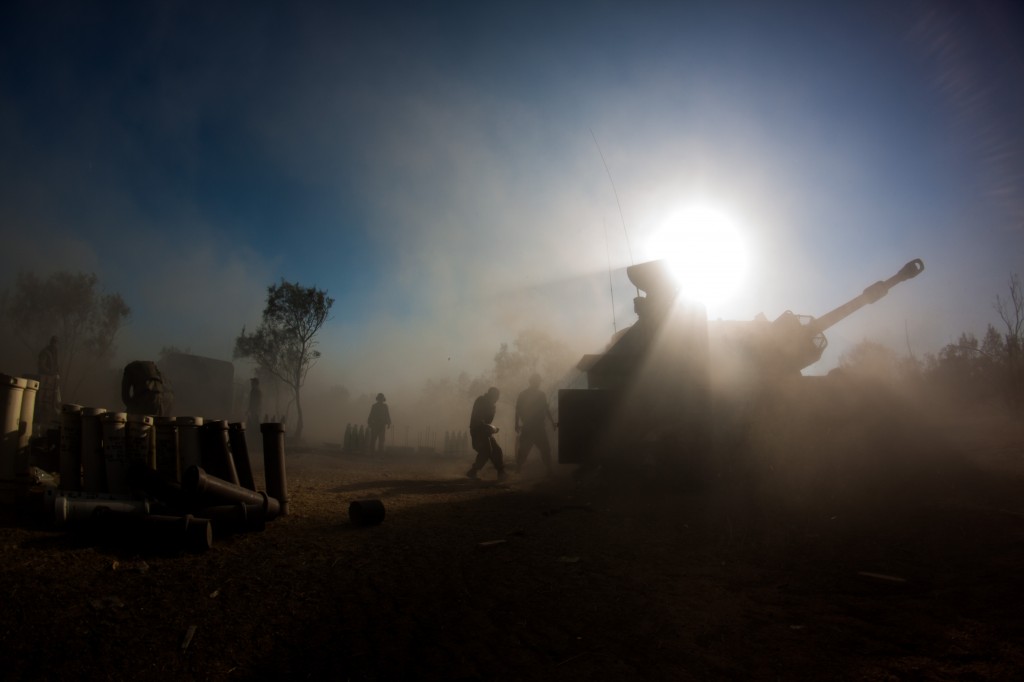
IDF artillery forces fire into the Gaza Strip on July 16 as part of Operation Protective Edge. Photo: Israel Defense Forces / Wikimedia
Distinction, the most important principle for an army to observe, is codified in Articles 48, 51, and 52 of the Geneva Conventions’ Additional Protocol I, which state that warring parties cannot target or intentionally harm civilians or civilian objects. However, active combatants and military objectives are targetable at all places and all times, subject to jus in bello proportionality. According to the International Committee of the Red Cross, civilians lose their immunity from being directly attacked “for such time as they take a direct part in hostilities,” or when civilian objects become “military objectives.” In case of doubt, a civilian object is presumed to not be used for a military purpose. Basically, a house is a house, a school is a school, and a mosque is a mosque—and therefore immune from attack—unless it is known to be a used for a military purpose. Then it becomes a lawful military target. These exceptions are important when determining the legality of Israel’s military strikes in Operation Protective Edge, since only deliberate attacks directed specifically at civilians or their objects are considered war crimes under the International Criminal Court’s statutes.
The IDF does not, as a policy, target civilians or their objects. Its Doctrine’s concept of “Purity of Arms” forbids soldiers from harming non-combatants and obligates them to “do all in their power to avoid causing harm to their lives, bodies, dignity and property.” Since 2009, the IDF has updated its already exacting urban-war doctrine to further protect civilians, and, through the Military Advocate General Corps, trains its soldiers to comply with the principle of distinction. But this noble policy, unfortunately, cannot speak to the action of every IDF soldier, nor of every questionable action undertaken by the IDF. All incidents, including those that have earned international opprobrium, must be judged on a case-by-case basis and through thorough investigations to determine whether war crimes occurred.
A house is a house, a school is a school, and a mosque is a mosque—and therefore immune from attack—unless it is known to be a used for a military purpose. Then it becomes a lawful military target.
However, reports from Gaza-based journalists have repeatedly indicated that Hamas officials were seen using hospitals as headquarters, and that rockets were being stored in mosques and fired from residential neighborhoods and schoolyards. Not only that, but Hamas members have also admitted to converting civilian buildings for military use. Hamas militants captured during fighting in Gaza admitted their organization used mosques for military activity, and that their tunnels have been built near kindergartens and clinics. The Shin Bet has documented interrogations with multiple captured terrorists who have made these admissions. These reports add a different dimension to the analysis.
Six UNRWA schools were hit by IDF strikes. In multiple cases, the IDF said it was returning fire from the vicinity of the schools. There is also ample evidence to demonstrate that UNRWA schools have been used by Hamas to store rockets and weapons. Evidence has also surfaced that UNRWA officials have handed over weapons discovered in their school to Hamas. A rocket-launching site was located near the Jafar Ali Ibn Taleb School in the Zeitoun neighborhood in Gaza City, from which a rocket was launched into Kibbutz Nahal Oz, killed 4-year-old Israeli Daniel Tregerman. Over 36 rockets were fired at Israel from two school compounds in the Shujai’ya neighborhood during the month of August alone. Regarding the July 24 strike on a school in Beit Hanoun, the IDF claimed it “encountered heavy fire in the vicinity of the school, including anti-tank missile,” from Hamas operatives in the school, and stated that a single errant IDF mortar landed in the school’s courtyard, but did not cause the casualties; evidence suggests that it was a Hamas rocket which caused the 16 deaths.
Israel has also carried out strikes against multiple civilian hospitals in Gaza, which is forbidden by Article 18 of the Fourth Geneva Convention unless they are “used for any [military] purpose which would deprive these hospitals of protection.” Article 19 continues that the protection afforded to hospitals ceases when “they are used to commit…acts harmful to the enemy,” but only after due warning has been given to the occupants. Reports have surfaced that certain hospitals, like Al-Wafa and Al-Shifa, have been used by Hamas as command centers, for weapons storage, and as firing positions on IDF troops, which would justify direct targeting of the hospitals, subject to proportionality. Shin Bet interrogations with Hamas members captured in Gaza have revealed extensive use of hospitals for military purposes: The leadership of Hamas in Gaza, including Ismail Haniyeh, were hiding in bunkers underneath Shifa hospital; Hamas bodyguards were positioned in the reception area at Nasser hospital in Khan Yunis; Hamas and Palestinian Islamic Jihad operatives were stationed in Rafah’s Al-Najjar hospital, in some cases forcing injured civilians to leave. In these instances, civilian hospitals were used as military headquarters and became, for all intents and purposes, targetable military objectives. However, in cases where rockets were only fired from the “vicinity” of the hospitals—as Human Rights Watch claims—then directly targeting the hospitals themselves would neither be justified nor legal. Only proportional and incidental damage from attacks on the military targets would be justifiable. Nonetheless, full investigations must be carried out before coming to any conclusions.
The IDF has also carried out strikes against multiple mosques, which are normally immune from attack. On the face of it, these attacks seem to be a violation of distinction, but Shin Bet interrogations with captured Hamas members confirms IDF intelligence reports that mosques are being used by Hamas for military purposes. According to these corroborated reports, Hamas ran a training camp in Khan Yunis’ Al-Shafi Mosque, where fighters were trained to fire antitank missiles in an underground room. Mosques in Khan Yunis were used to conceal war materiel like RPGs, heavy PKC machine guns, and other ammunition. The Al-Salah Mosque served as a meeting point for Qassam Brigade terrorists before carrying out military activities against the IDF, and the Al-Bana Mosque was a meeting point for Qassam Brigade tunnel fighters. The Abdel Rahman Mosque in Greater Ibsan was used to monitor IDF movements. Two IEDs were concealed in the city’s Altawhid Mosque. The Al-Taqwa Mosque was used as a lookout from which orders were passed along to terrorist to plant IEDs. Hamas turned these mosques into military objects, and therefore made them targetable under international humanitarian law.
Regarding the July 16 strike of a shack on a beach, which killed four children, the IDF claimed it was targeting an “identified Hamas installation” and mistook the boys for “fleeing fighters.” IDF spokesman Lt. Col. Peter Lerner said that IDF intelligence specifically pointed to that location and indicated the presence of Hamas terrorists. “We [also] had visual surveillance…to an extent that we should have been able to determine who was on the beach.” However, Human Rights Watch claims the IDF used Spike missiles with mounted CCD/IIR devices in the attack, allowing the operator to observe the target and divert the missile “if last-second doubts arise about the target.” Lt. Col. Lerner responded that the IDF was investigating “what happened between the gathering of the intelligence and what happened that caused this unfortunate human tragedy.” Pillay said that the strike was likely a war crime, raising “concerns about respect for the principles of distinction, proportionality and precautions in attack.”

IDF’s elite Skylark unit, nicknamed the “Sky Riders,” served as the eyes of Operation Protective Edge. The Sky Riders provided live footage of events in Gaza. Photo: Matanya / Wikimedia
The determination of whether these attacks were intentionally targeting civilians, in contravention of international humanitarian law and the IDF’s own doctrine, and therefore war crimes, is still premature. However, the IDF’s past performance unequivocally demonstrates Israel’s strict compliance with international law and its own Purity of Arms Doctrine’s requirement not to harm or target civilians intentionally. The Red Cross’ “Zero-casualty warfare” report indicates that since the mid-20th century, 10 civilians have died for every combatant killed in modern warfare. The IDF has traditionally succeeded in reversing that ratio.
The IDF’s first experience with major urban combat was the 1982 Lebanon War, its bloodiest urban engagement to date. Yet, according to Lebanese governmental estimates, by the end of the seven-week siege of Beirut, the ratio of civilians to combatants killed was 6 to 1, considerably lower than the Red Cross’ standard. During the Second Intifada, Israeli airstrikes on Gaza resulted in a 1:1 ratio from 2002-2003. The ratio vastly improved to 1:28 in 2005. After the Intifada ended, it declined to 1:10 in 2006, but improved again in 2008 to 1:30. Harvard law professor Alan Dershowitz called this “the best ratio of any country in the world that is fighting asymmetrical warfare against terrorists who hide behind civilians.”
During the Second Lebanon War in 2006, Amnesty International and the Lebanese government estimate that a total of 1,191 civilians and combatants were killed. Human Rights Watch put the number at 1,109. The IDF estimates that 600 to 800 of those were Hezbollah fighters; the UN’s official estimate is 500 fighters. Even according to the worst estimates, that’s a ratio of approximately 1:1. Considering the fact that Hezbollah fully embedded its military structure into the civilian population, such a low ratio can only attest to the considerable efforts the IDF took to spare Lebanese civilians from the effects of the war.
In Operation Cast Lead of 2008-2009, the final IDF report—corroborated by Hamas, no less—identified a total of 709 combatants killed out of a total of 1,161 Gaza fatalities; 295 were positively identified as civilians and 162 men killed could not be verified. That puts the casualty ratio at 1:3. That ratio was a result of Israel’s huge investment in special weapons systems like smart bombs, intended to minimize collateral damage to civilians. In fact, 81 percent of the 5,000 missiles the IDF dropped in Operation Cast Lead were smart bombs, an unprecedented percentage in modern warfare. The IDF also stepped up its efforts to warn civilians to flee targeted areas, and diverted missiles at the last moment if civilians entered a planned strike zone. It is true that the Goldstone Report claimed Israel targeted civilians as a policy and a strategy, but even Justice Richard Goldstone himself recanted this baseless assertion.
The IDF is the most successful army in the world at avoiding civilian casualties during urban warfare.
Operation Pillar of Defense bore out a similar result. At the end of the eight-day operation, Israel claimed 120 combatants had been killed. Palestinian figures claimed 55 militants and 105 civilians were killed, whereas the NGO B’Tselem put the number at 87, putting the ratio at 2 civilians for each combatant, even according to the worst estimates.
While these numbers are not conclusive evidence of the legality of Israel’s strikes, they do demonstrate that Israel is not systematically and indiscriminately killing Palestinian civilians. When the numbers are put in perspective, the civilian casualties resulting from Israeli strikes appear very low.
Given the IDF’s track record, it is more than fair to assume they were complying with international law and only targeting militants and military objectives in Operation Protective Edge as well, and that the civilian deaths that resulted were collateral and not intentional. How then is the legality of the IDF’s actions to be judged? Do any civilian deaths automatically make an attack a war crime?
Israel’s critics say the bare fact of civilian harm conclusively proves its criminality. They reason that a high number of civilian casualties automatically means that war crimes have been committed. Jimmy Carter used these numbers to demand an investigation into Israel’s actions. “There is never an excuse for deliberate attacks on civilians in conflict. These are war crimes,” Carter said. “Three Israeli civilians have been killed by Palestinian rockets, while an overwhelming majority of the 1,600 Palestinians killed have been civilians.”
For the sake of accuracy, it must be stated that—according to an analysis by the BBC—it is still unclear “how many of the dead in Gaza are civilians and how many are fighters,” since the focus so far has been on recording the casualties and not a detailed analysis of their composition. Drawing conclusions based on the raw numbers of casualties is still premature (though a study by The New York Times has indicated that the age and gender group most over-represented in the casualty list are those most likely to be terrorists).
The Gaza Health Ministry—essentially controlled by Hamas—claims 2,016 people were killed, among them 541 children, 250 women and 95 elderly men. The Palestinian Centre for Human Rights puts the number at 2,168, and claims 1,662 of them were civilians, while the UN’s Office for the Coordination of Humanitarian Activities says the number was 2,101, of whom 1,460 were civilians, 265 were militants and 376 were unknown. The IDF’s numbers, as of August 11, were 2,000 killed, including 1,000 militants. Israeli casualties stood at 64 soldiers and 6 civilians. The numbers are indeed lopsided, but assuming that the very existence of civilian deaths is conclusive evidence of Israel’s guilt warps the test of criminality under international humanitarian law.
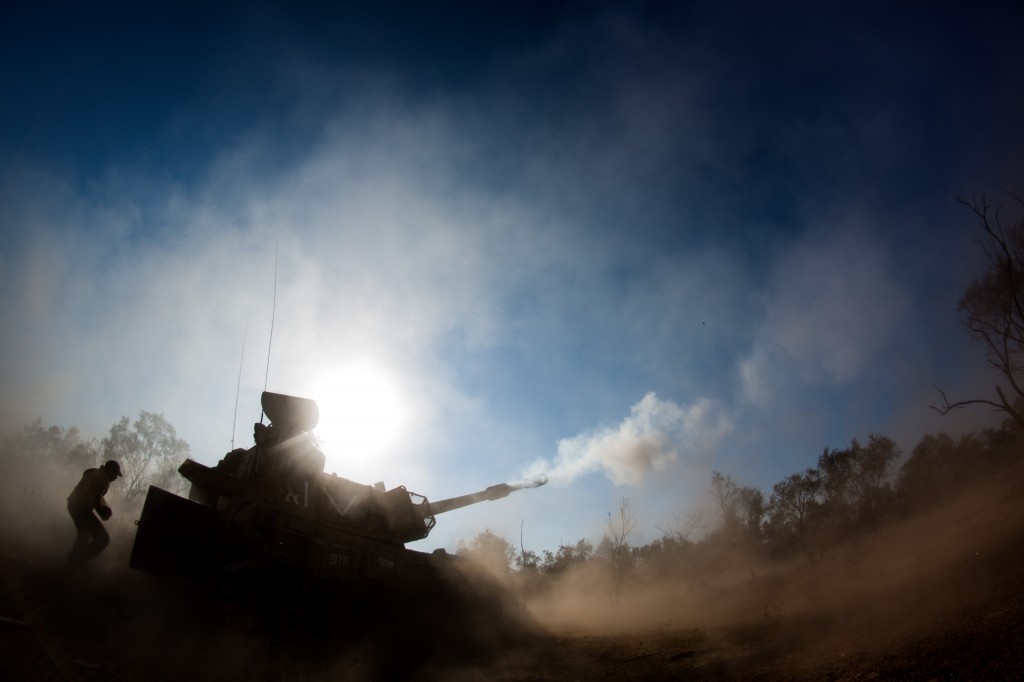
IDF artillery forces fire into the Gaza Strip on July 16 as part of Operation Protective Edge. Photo: Israel Defense Forces / Wikimedia
The concept of “military necessity” allows a state to do anything lawful—within the bounds of proportionality—to defeat the enemy. It permits collateral civilian death and injury ancillary to destroying particular military objectives that provide some type of advantage in weakening the enemy military forces, as long as only necessary force is employed. However, military necessity should not be confused for military convenience. According to Article 23 of the Fourth Geneva Convention, military necessity forbids destruction of enemies and their property, “unless such destruction…be imperatively demanded by the necessities of war.” The political ethicist Michael Walzer emphasized that this does not mean “doing whatever it takes”—it only permits lawful measures and “can only justify killing people we already think are liable to be killed.” Every injury done to the enemy’s civilians and combatants, even in a permitted action, is lawful only insofar as it is absolutely necessary and provides a military advantage. Though international humanitarian law protects the civilian population, it also, according to Gary D. Solis of the Georgetown University Law Center, “permits bombardment of a military objective containing civilians if there is reasonable evidence that the objective is sufficiently important to justify the bombing, despite danger to civilians.”
International humanitarian law does not prohibit causing civilian casualties. Article 51 of the Geneva Conventions’ Additional Protocol I only prohibits “indiscriminate attacks” on civilians, those not “directed at a specific military objective.” Solis adds that a military target can be attacked, even “knowing that [civilians] will inevitably be killed.…This is not a violation of distinction. Any civilians killed or wounded are collateral to the attack on the legitimate target….To hold…that no objective is lawful if civilians might be killed within that objective, would preclude virtually all military targeting.” Distinction and proportionality do not require the elimination of civilian casualties, but striking a reasonable balance between military necessity and humanitarian responsibility.
When dealing with an organization like Hamas, which hides among civilians, stores weapons in civilian buildings, doesn’t use uniforms or openly carry its arms, and uses civilian areas as launching pads for indiscriminate rockets directed at Israel, it’s highly difficult to avoid civilian casualties.
International law does not envision or expect the total elimination of civilian casualties. The International Criminal Court Statute’s Article 8(2) only prohibits intentionally launching attacks on legitimate targets, “in the knowledge that such attack will cause incidental loss of life or injury to civilians or damage to civilian objects…which would be clearly excessive in relation to the concrete and direct overall military advantage anticipated.” Civilian deaths, alone, are not evidence of criminality. No country is required to ensure that its military attacks completely eliminate civilian casualties.
According to the Red Cross itself, it’s often tricky to determine whether the level of casualties is excessive, even under ideal circumstances. An inquiry must not only determine the identity and number of civilian casualties, but also, as Peter Berkowitz, a senior fellow at the Hoover Institution, put it, “[go] into tactics and strategy, battlefields and weapons, what troop commanders knew and what they reasonably could have known.” Israel has admirably tried to reduce the ratio of civilians to combatants killed, and succeeds more often than not; but even with advanced military technology, civilian casualties will unfortunately occur.
This complication is further compounded when dealing with an enemy like Hamas, which hides among civilians, stores weapons in civilian buildings, doesn’t use uniforms or openly carry its arms, and uses civilian areas as launching pads for indiscriminate rockets directed at Israel. While Hamas’ “human shield” strategy does not (contrary to popular belief) eliminate Israel’s own responsibility to continue complying with the principle of distinction and proportionality in its attacks, it certainly makes it more difficult, and the resulting civilian casualties are not such a clear-cut indication of targeting of civilians or war crimes.
Nonetheless, Israel is obligated to take reasonable measures to minimize civilian casualties. Parties must give “effective advanced warning” before launching an attack that may affect civilians. The IDF has various methods of complying with this obligation. One method is “knocking on the roof,” firing a non-lethal projectile at a building’s roof, giving occupants a reasonable amount of time to evacuate before the actual strike. Before “knocking on the roof,” the IDF calls residents to warn them of the incoming projectile. The UN has stated that during Protective Edge, in most of the cases where Israeli Air Force strikes resulted in civilian casualties, the IDF called to warn occupants to flee. The Air Force has also adopted the practice of dropping leaflets on targeted areas prior to strikes, warning civilian residents to flee in advance of an imminent strike.
Admittedly, Israel’s obligations don’t end with early warnings. The attacking party must take all reasonable precautions to protect civilians in the course of an attack, and to call off or suspend attacks if the civilian collateral damage would be excessive. Article 58 of the Geneva Conventions’ Additional Protocol I obligates parties to protect civilians against the collateral effects of an attack. But, as Dinstein says, “Much depends on the factual situation,” so, as the IDF readily acknowledges, a legal review is carried out before each strike is undertaken. Before strikes, the Air Force sends out an unarmed plane from the Camel Squadron to determine whether the strike should be carried out, or aborted because of the civilian presence. Even after that determination, gun cams routinely show pilots breaking off engagements after determining that the strike would cause a disproportionate loss of civilian life, even after using its warning methods. Unfortunately, it is not always possible to make such a determination without the benefit of hindsight.
Questionable incidents during Operation Protective Edge cannot be answered with the IDF’s previous valiant behavior in war. They must stand or fall on their own. But an army that has so consistently acted with a restraint beyond that which is required by international law can reasonably be expected to have done so again. All that can be said with certainty at this point is that, given the information available, some incidents do raise questions that the IDF must answer. However, past experience virtually negates the likelihood of widespread violation of international humanitarian law by Israel’s soldiers. So why is it that the UN commission investigating Protective Edge is only looking into Israel’s actions, and not also those of Hamas, which violates international law by using human shields, staging attacks from within civilian areas, and indiscriminately attacking Israeli civilians? The commission itself may have already given the answer.
William Schabas—appointed to the UN commission investigating Israel’s actions in Protective Edge—has said it is his “profound belief that international law can be used to demonstrate and underscore the violations committed by the State of Israel,” further adding that he would like to talk about “crimes against humanity, war crimes, and the crime of aggression, all of which I think can be shown to have been perpetrated at various times during the history of the state of Israel,” concluding that “with a bit of luck and by twisting things and maneuvering we can get [Israelis] before the courts.” More recently, Schabas admitted to the existence of legal double standards against Israel, explaining,
The fact that there haven’t been inquiries into some atrocities, into some areas of violent conflict in the world, is explained by the political balances and the relative strength of the powers. That’s a very unfortunate situation, but that’s a fact of life. And different crises and different countries fare differently, depending on where they are…we unfortunately live with that as a reality in the world situation.
The behavior of many other jurists demonstrates that they hold these same troubling and, frankly, dangerous views, though they may not be so bold as to openly admit to it. But justice doesn’t need “twisting” and “maneuvering.” A jurist’s personal biases should play no part in a legal determination. The very idea of double standards in law is repugnant, oxymoronic and self-defeating. Law must be objective and blind. It cannot serve political ends, no matter how noble, and definitely not political power interests. In determining guilt and innocence, it cannot allow for the subjectivity exhibited by Schabas. Otherwise, countries that abide by international humanitarian law will be increasingly limited from defending their civilians against unscrupulous actors that ignore and exploit the laws of war. These actors will, in turn, be encouraged to commit further atrocities shielded in the knowledge that “power interests” will protect them from accountability. Legal military actions will be labeled “war crimes” because “political balances” demand it. Real genocides and crimes against humanity—like the extermination of the Yazidis and other minorities currently underway in Iraq—will go unanswered if “power interests” wish to give the perpetrators immunity. Nations otherwise inclined to intervene will refrain out of fear that their leaders, military commanders, and soldiers might be arbitrarily subjected to prosecution if “power interests” dictate it. This leads to an environment where criminals are free to act with impunity, but those who would uphold the peaceful international order have their hands tied behind their back and can only sit and watch in horror as massacres unfold around the world.
The law will be discredited and disregarded in the interest of self-preservation if it is used to impair lawful self-defense. If countries see international humanitarian law as hopelessly impractical, it will undermine their own soldiers’ sense of justice and imperil the other sides’ civilians—the opposite of the effect intended by the idealist jurists using law for their political ends. Defending the law’s integrity is therefore not only in the interest of states, but also the interest of individuals enjoying the protections these laws afford.

Canadian academic William Schabas is leading the UN’s inquiry into alleged Israeli war crimes committed during Operation Protective Edge. Photo: Deep Dish / YouTube
The law must not be used against Israel as a political weapon simply because Schabas absurdly wants to drag Israeli Prime Minister Benjamin Netanyahu before the International Criminal Court. No state should be held to a higher legal standard than others, even if the motivations are noble political ends, or highly positive views of that state. The very notion is absurd. Law must be objective and blind to the identity of the parties, judging individuals and states by their actions, not vice versa. Otherwise, the result is not justice, and law becomes a popularity contest.
Innocent civilian deaths are always tragic, and it may seem heartless to deal with human suffering as a legal calculus, but law must be emotionless, and it is in the paramount interest of justice to determine whether Israel or Hamas have committed war crimes or not. If Israel has violated international humanitarian law—as a policy or in individual actions—then let its soldiers be judged guilty, but only insofar as international humanitarian law requires. But if it hasn’t, then sympathy for the plight of the Palestinians must not lead to the distortion of a noble legal system in order to judge the innocent guilty simply because this would create a desired political outcome.
The 17th century writer Samuel Rutherford wrote a defense of the rule of law and defensive wars entitled Lex, Rex— “The Law is King.” And indeed, as Thomas Paine said, “The law ought to be king; and there ought to be no other.” Subordinating international law to politics or power interests, to subjective whims and feelings, will backfire. The legitimacy of international law depends on its ability to transcend politics and power interests. Uprooted from its necessary objectivity, law becomes a meaningless tool of power, another form of tyranny.
![]()
Banner Photo: Lybil / Wikimedia







